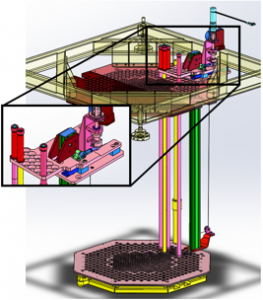Investigation of mechanical noise induced by fuel rod vibrations
The aim of the COLIBRI (CROCUS Oscillator for Lateral Increase Between umetal Rods and Inner zone) experimental program in CROCUS is to investigate the radiation noise related to fuel vibrations. It consists in carrying out experiments on rod displacement (static) and oscillation (dynamic) with a variation of both number and configuration of oscillated rods at relevant ranges of amplitudes and frequencies.
In-core oscillation of 18 periphery fuel rods of CROCUS in critical operation (±1.5 mm around nominal position, 1 Hz).
The main motivation for this investigation is the increased amplitudes in the neutron noise distributions recorded in ex- and in-core detectors that have been observed in recent years in Siemens pre-Konvoi type of pressurized water reactors. Several potential explanations have been put forward, but no definitive conclusions could be drawn yet. Among others, changes in fuel assembly or pin vibration patterns, due to recent modifications of assembly structural designs, were pointed out as a possible cause. Such mechanical noise is suspected to arise from vibration of groups of fuel assemblies. Computational dynamic tools are currently developed at the Paul Scherrer Institute, as well as within the Horizon 2020 European project CORTEX, to help with understanding the additional noise amplitude. The COLIBRI program is used for their validation.

Sketch of the fuel rods oscillator with core structures and a few rods inserted in the device.
An in-core device was designed, manufactured, tested, and licensed between 2015 and 2019. Limited modifications of core structures and fuel rods were required. Licensing and tests were conducted in successive steps from out-of-pile tests with dummy fuel rods to in-core tests under critical operation. The device allows simultaneously displacing up to 18 fuel rods. The maximum oscillation amplitude is 5 mm, i.e. ±2.5 mm around their nominal position in the lattice, while the maximum allowed frequency is 2 Hz, i.e. in the frequency range in which the induced neutron flux fluctuations are most pronounced in nuclear power plants. The first experimental campaign was carried out in September 2018. The program will finish it first phase at the end of 2019, and continue in 2021.